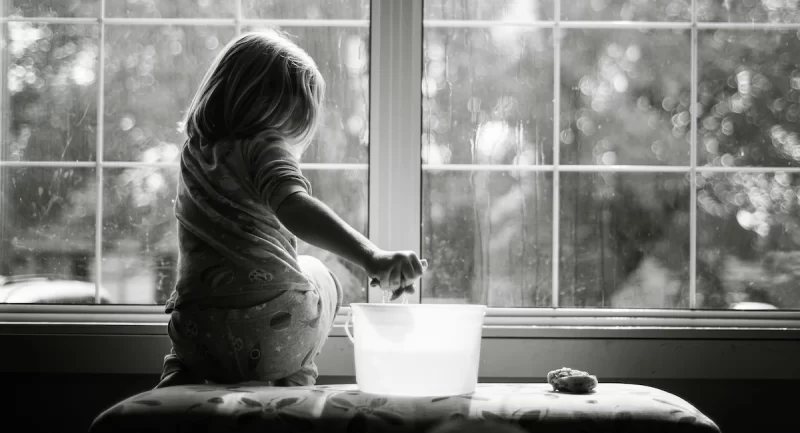Each of the seven posts in this series includes a song at the beginning. These songs have their roots in the culture of Rajasthan and are intended to instill in you the same feeling I experienced during this trip. Tip: Use picture-in-picture mode to let the video play in the background while you read the post.
Almost all aspects of the Marwari life can be experienced in the rich, evocative, and nostalgic music of Jodhpur. Varying feminine moods and strong family ties are the main themes of songs sung by women here. Songs about family frequently include a comparison of every member to the several ornaments worn by women. In this particularly popular Rajasthani song ‘Kaajaliyo‘, the woman lovingly describes how her husband is never far from her and remains close in the form of Kohl in the eyes or the jewel in her ring.
*****
As I set foot on the soil of Marwar, I realized this is where my ancestors were born, where my culture had evolved and been carried forward for centuries.
I had visited Rajasthan countless times before, but for the first time in twenty-six years, I felt a true connection with this land.
The events of being pickpocketed in Ajmer and then feeling renewed with energy in Pushkar were still fresh in my mind, but this day was going to be even better.
The RSRTC Volvo Scania 2X2 Semi-sleeper bus from Ajmer took me to Jodhpur in about 4 hours. An auto-rickshaw from the bus stand dropped me at Ghantaghar – or Clock-tower – a transitional gateway between the Old and Contemporary Jodhpur.
On one side were wide roads with commercial buildings and bustling traffic. On the other side were narrow streets, preserved Havelis and traditional markets. I got down at the entrance of the clock tower and walked the last mile to my accommodation in the blue city, Zostel Jodhpur.
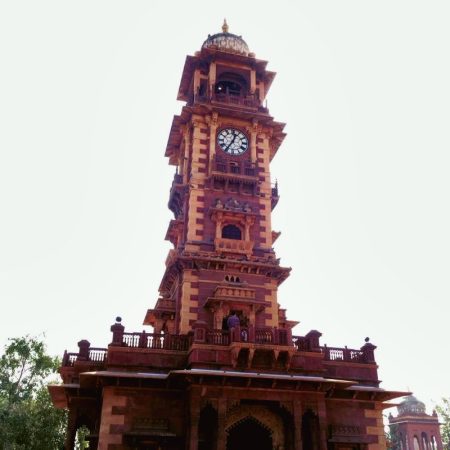
After keeping my luggage, I was hurrying to leave for Mehrangarh fort, when a young and energetic guy from the hostel reception stopped me in my plans.
“Visit Jaswant Thada first, it will get closed soon. Let me tell you about a shortcut”, Tej said.
Heading toward this mysterious shortcut, I quickly lost my way, wandering through the streets and taking a peek at rural life!

An uphill hike from the underlying town to the road leading to Mehrangarh Fort, followed by a courageous decision to climb structures I wouldn’t usually dare to alone, finally brought me to a small, broken opening at the rear end of Jaswant Thada’s parking lot.
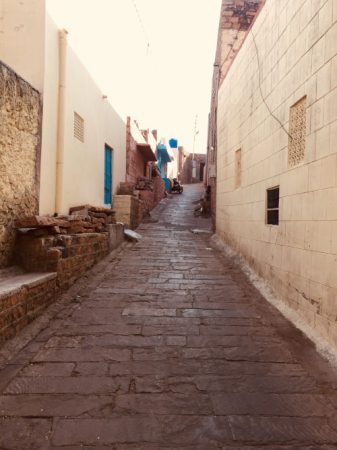
Jaswant Thada - the Taj Mahal of Marwar
Jaswant Thada is a cenotaph made of pure white marble that retains its luster even today. It emits a warm glow when illuminated with bright sunlight, and people call it the ‘Taj Mahal of Marwar’.

I opened my shoes and walked barefoot on the cold marble. The mausoleum houses several paintings of previous Marwar rulers. The whole interior glowed brightly with the reflected rays.
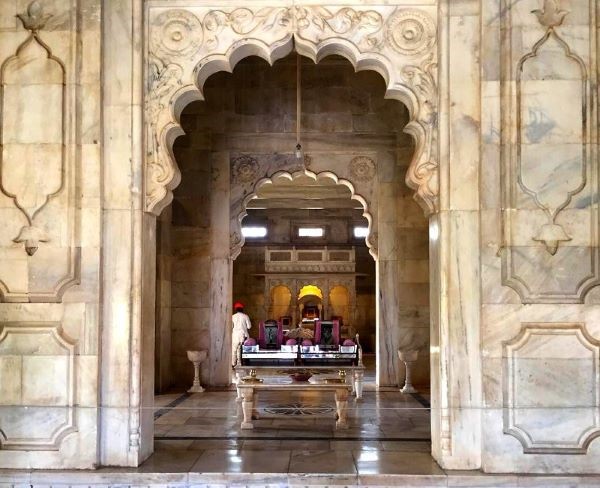
There is a shallow lake and a beautiful tiered garden lining Jaswant Thada. Local folklore is that during the construction of the cenotaph, a peacock deliberately jumped into the waters and gave away its life.
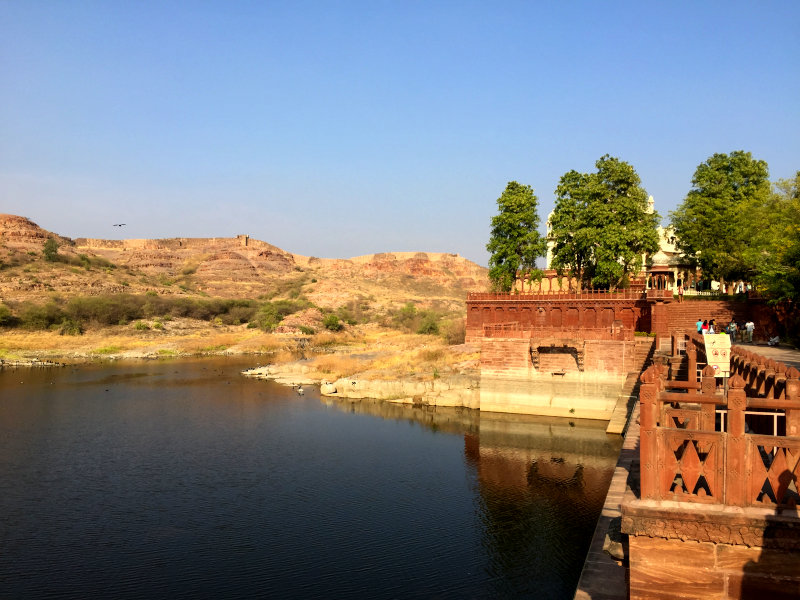
The quiet lake, the colorful garden, and a lack of too many visitors in particular made the surroundings very peaceful. I sat down for a while, looking at the lake and the birds.
While exiting from the main gate, I saw a local musician playing melodious folk songs on Gujari, a traditional Rajasthani instrument.
After enjoying some free live music, I paid him to play Ghoomar, a popular Rajasthani song.
Bearing in mind that I was only an hour or so away from the sunset, I decided to head directly towards Mehrangarh fort and reach there on time, lest it got closed.
Mehrangarh Fort—an architectural masterpiece
I have visited a number of forts in India, but Mehrangarh fort now holds its own special place in my heart. Situated at a towering height of more than 400 feet above the city, it exhibits a commanding appearance while blending into the landscape.

It has a magnificently designed interior with multiple palaces and museums portraying the heritage of Rathores in arms, costumes, paintings, and jewelry.
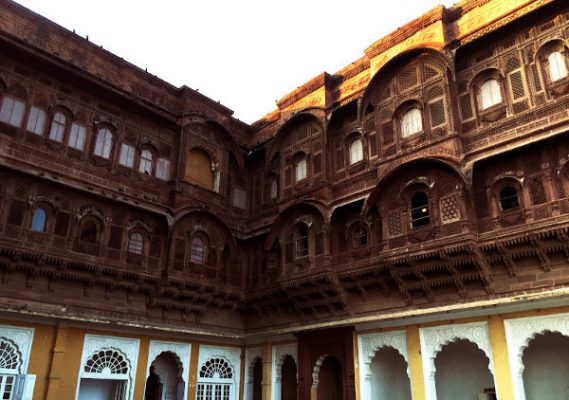
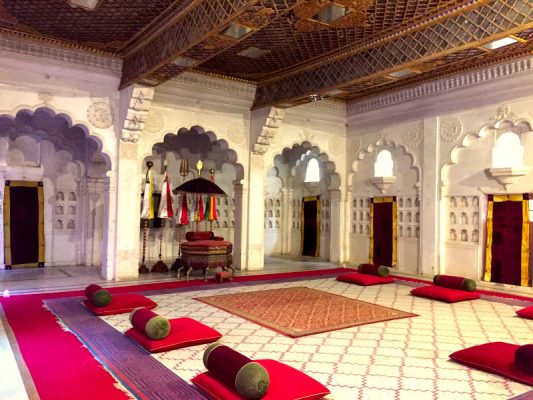
The Fort and its palaces have been gradually built over a period of around 500 years. So if you look carefully, variations in the building styles from different periods of time can be identified easily. It is one of the features that make the Mehrangarh fort so remarkable.
There is an option to take a tour/audio guide for a detailed description of each part of the fort. But even if you don’t, historical information and significance are provided throughout the fort in Hindi and English.
I spent over two hours exploring the fort. The sun had set on the horizon, and most of the tourists had left.
Towards the end of the fort, there was a long passage that led to the temple of goddess Chamunda Devi, where puja is conducted every evening.
I reached just in time. There was utmost peace and silence, broken only with the occasional, soothing chime of a bell. The diyas were lit. It was time for the evening aarti.
Brightly lit markets of Jodhpur
I left the fort around 7:30 PM and returned to the clock tower.
While taking a stroll through Sardar Bazaar, I realized that it looked strikingly similar to the burra bazaar in Kolkata. I also came across a few shops with beautiful local handicraft items, paintings, and mojari on display, among other things.
Somewhere near Manak chowk, an old guy was selling mouth-watering golden fried bhajiya (pakora). I held an assortment of potato, onions, cauliflower, and spinach bhajiyas (with coriander-chili chutney) in one hand, a cup of ginger chai in the other – and savored every flavor of both of them.
I wondered why people spend thousands elsewhere when happiness is sold for 20 bucks on the side of the street. More chutney, please.
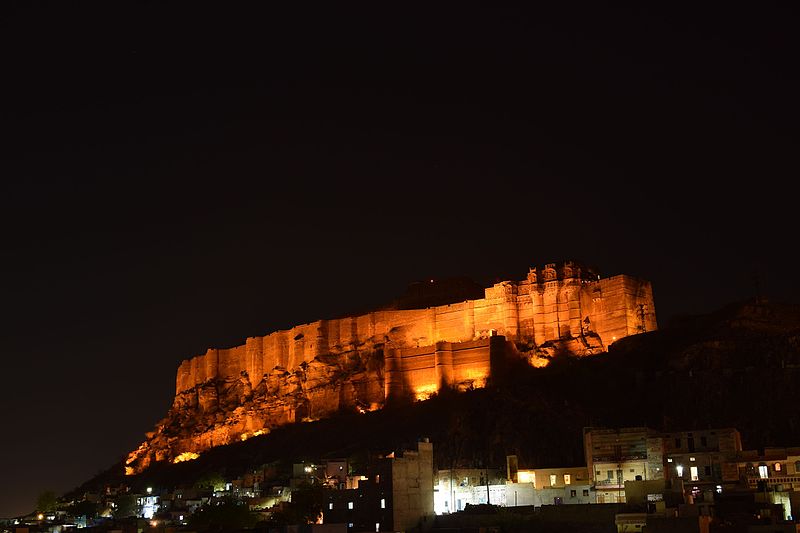
At night, I went to the rooftop cafe above Zostel, and my heart filled with a satisfaction that I hadn’t experienced in a long time. Right in front of me was Mehrangarh fort, glittering in golden colors. The cafe had no lights, only candles on the table, which made the ambiance even more pleasing.
As I ate my meal – shivering intermittently due to the cool breeze – I couldn’t help but smile at the feeling of immense happiness inside. I felt grateful, for having decided to come on a solo trip to Rajasthan; blessed, to have had a connection with this amazing land; and proud, to have challenged everything for this ineffable experience.
But more than anything else, I felt free.
Inside the Blue City - the alleys of Navchokiya
Next morning, the weather was sunny. When I woke up, everyone else from my dorm room had already left.
My original plan was to visit the Umaid Bhawan Palace and catch the art workshop. But it turned out that everyone except me knew it was closed for Priyanka Chopra and Nick Jonas’ wedding.
So I decided to take a walk through the city.
I started with Toorji ka Jhalra, a step-well located just a few hundred meters from my hostel. Step wells are large wells that were built during the rule of Maharajas to conserve water in the arid regions of Rajasthan and Gujrat. It is like a combination of a pond and well, with steps on the sides that lead you to the depths.
After clicking a few pictures, I went to a popular place called Stepwell cafe. It had great options for contemporary food but was somewhat heavy on the pocket for someone who just quit their job (ahem). So, I only had an iced tea.

From here, I explored the interiors of the city—Navchokiya, or the blue alleys of Jodhpur.
While the pink city is not as evidently pink, the blue city is certainly blue! Almost every house in the community has walls painted with roughly the same shade of color.
The quiet, narrow lanes reminded me of the serenity and simplicity that had been missing in my life for a while. And I had a brief episode of nostalgia.
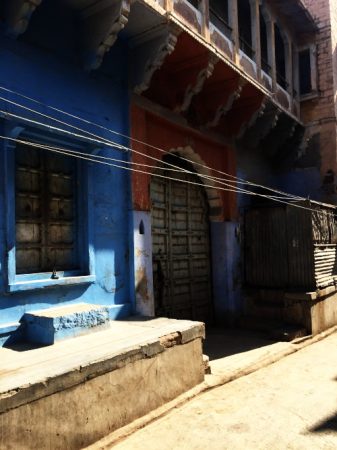
I recalled the image of a four-year-old boy standing on the terrace of a half-constructed house at the foot of a hill.
I recalled the smell of that spring breeze, carrying with it the sound of kulfi-walla ringing his bells. And I recalled my excitement over it along with the other children.
I remembered the swift steps that I would take while driving a herd of goats from the house to the farm. There were only glimpses of these memories alive in my mind, but they were still vivid. And I felt a longing inside to go back into the silence of those afternoons.
Of course, there were no farms or fields in front of me, but the blue houses reminded me of old, rural Rajasthan. Maybe this is why I subconsciously wanted to come on this solo trip.
In the late afternoon, I went to a place called Vijay Restaurant in Katla Bazar for lunch, as suggested by Tej from Zostel. It was a small eatery on the first floor, but the food was delicious and flavorful. A ravishing lassi made the perfect end to the meal.
I returned to the hostel, packed my stuff, and left to catch the evening train for Jaisalmer.
On my way, the auto-rickshaw driver engaged in conversation with me. He talked about various things, from places to visit in Jodhpur to the time his wife fell sick and was admitted to the hospital. I wondered—why was he sharing all this with me?
Then towards the end of the ride, he told me about his son, who had recently passed away due to a fever. I could see his eyes, filled with a feeling of forlorn. It was disheartening to realize that a large section of Indian society still remains far less privileged than most of us are.
Before leaving, I thanked him and assured him that everything will be alright. I had no idea whether it would be or not, but in that moment, I guess that was all I could do.
I came to the platform, rested my backpack on one of the benches, and sat there in silence, waiting for the train to arrive.
*****
This story is part of my solo trip series— Backpacking Rajasthan.
Check out the entire series here.

